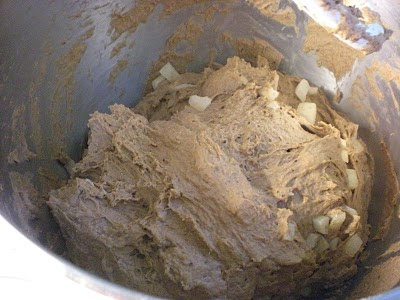Bread Maiden apologizes for her long hiatus from blogging. So much has happened in the past six months and she hopes that as the dust settles she will post a little more often.

Bread around the Bread Maiden household has been pretty routine- I've gotten into the habit of making my standard 1-2-3 sourdough, sometimes mixing it up with a wheat or multigrain loaf. But while those are great breakfast breads, they aren't very exciting.
However, the bread I am telling you about now IS kind of exciting.
But I need to provide some background first.

Since moving back to the DC area from Austin (big change #1), Mr. Bread Maiden has been canning, preserving, and fermenting like crazy.

This is Mr. Bread Maiden fermenting mead. What is mead? This is mead.

Crazy, huh?
Here is a picture of mead on the left, and hard cider on the right.

Cider is where I come in.
As you may remember from previous posts, yeast is used in many things, and can come in many forms.

And yeast that has been used in beer or other fermented drinks can be used in bread as well, after some prep work. Once the fermentation process is complete, the yeast settles on the bottom of the vessel. After the beer has been transferred from the carboy to bottles, the leftover yeast can be collected and stored, as it is here in the top tupperware.

Here is a picture of a pure beer yeast starter (on the right) and a starter that has been fed and discarded a few times (on the left).

This week Mr. Bread Maiden bottled his cider and had cider yeast left over. I checked online to see if anyone had heard of using cider yeast in bread. I found
this but nothing else.
So I decided to give it a try.

I threw a few tablespoons of the cider yeast into a glass jar and mixed in 100g of all-purpose flour and 75g of water. Then I left it to rise overnight, discarded most of it, fed it again, and waited another night.
By this time it was quite lively.
I threw it into my 1-2-3 bread.

That is where it sits now. Given the bubbliness of the starter, I'm confident that it will rise, at the very least.
I guess I should probably update when I actually bake this thing.
Meanwhile, I have the pleasure to report our Big Change #2:

We are expecting a Baby Bread Maiden in early 2011!
**UPDATE**
Ok, and we're back with the results of the cider bread.
This is a picture of the bread rising after a few hours and one stretch-and-fold.

You can see more of the rise here:

The bread was divided into two loaves for the final rise.

I threw my dutch oven into the oven and preheated it at 450 degrees. Then I baked the loaves one at a time after scoring them in my usual pattern. I baked them for 30 minutes with the dutch oven lid on, then 15 minutes with the lid off.
Here is what came out of the oven:

This is one damn beautiful loaf.
But how does it compare to a normal 1-2-3 sourdough loaf in terms of color, oven spring, holey interior, and taste?
COLOR

Comparing the cider starter loaf on the left and normal sourdough on the right, the color was about identical.
OVEN SPRING

Once again, the cider loaf and the normal loaf were about the same size and shape.
HOLEY INTERIOR

No real difference here. The holes in the loaves are about the same in size and frequency.
TASTE

No, this isn't a picture of the cider loaf. But you can't go too long on a blog entry without a picture.
The taste was really the only difference Mr. Bread Maiden and I could identify. While the cider loaf came out of the oven with a distinctive "sharp" smell, it had a milder taste than my normal sourdough.

Bread Maiden's parents, who tend to not like very sour sourdough, really liked the cider loaf.
This taste difference might not be directly a consequence of using cider vs. regular wild yeast starter. It could have more to do with the fact that the cider starter was much younger than my normal starter, and that I started the loaf in the morning and baked it the same night, instead of letting it go for longer fermenting time in the fridge.
So, what's the verdict? I'm not sure if I'm going to keep the cider starter after my grand cider bread experiment. It's enough just to keep one starter going, much less two. And the cider starter may get more intense over time, which makes the taste difference less of an issue.
If you like the idea of experimenting with other types of yeast in your bread but don't have cider yeast, don't despair. There are TONS of other yeasts, including yeast from fruit! Check out this very helpful
website.


 Lovely.
Lovely. 
















































